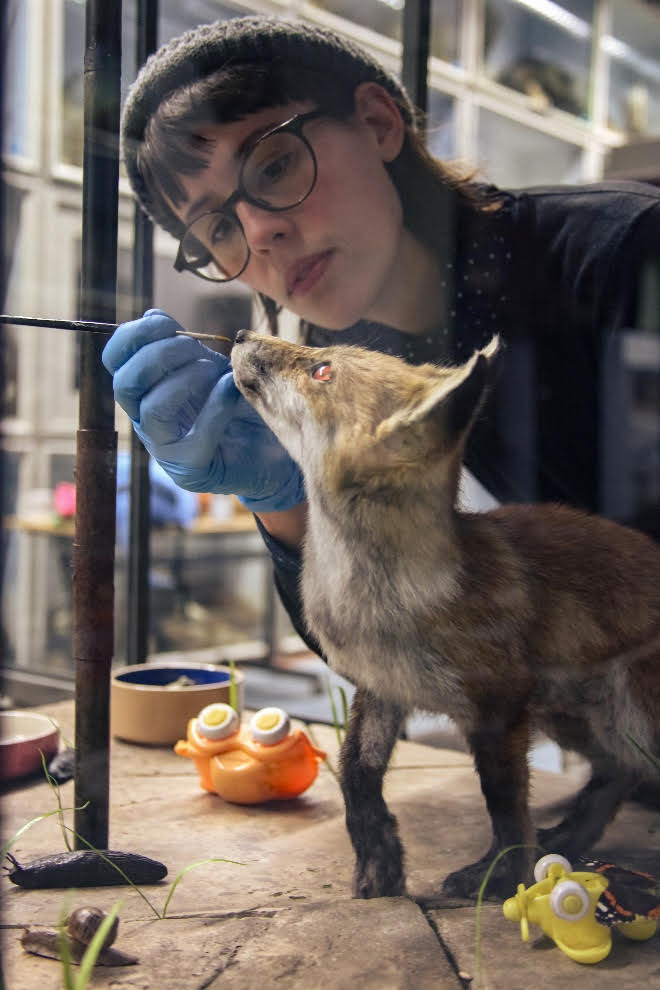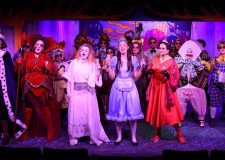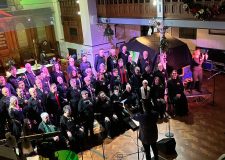First new diorama to be unveiled in Booth Museum of Natural History in nearly a century
A new “Life in the Garden” display inspired by Brighton & Hove children will celebrate wildlife in the city and the effects of climate change on the environment.
The display, called a diorama, is the first new one to be created at the Booth Museum of Natural History in Brighton in 92 years. The Booth is home to a collection of over a million natural history specimens, with British bird dioramas, stuffed exhibits in examples of their natural habitat, at its core.
The “Life in the Garden” diorama is the outcome of “Discover our Dioramas” an 18-month project, funded by Esme Fairburn MA Collections Fund. Staff at the Booth Museum worked and played with a range of local people including 2000 children under 10 years old, their parents and carers, educators, eco-groups and low-income groups through events and activities inside the museum and the city. Their feedback helped to decide what should be in the first diorama added to the displays at the Booth Museum since the 1930s.
The Booth Museum was founded in 1874 by Brighton based naturalist and collector, Edward Thomas Booth. During Booth’s lifetime he collected a wide variety of stuffed British birds and was a pioneer of the environmental type of display called ‘diorama,’ displaying birds in recreations of their natural habitat. Edward Booth left the museum to be enjoyed by the people of Brighton in his will and it was this collection of over 300 dioramas that launched the opening of the museum under Brighton civic ownership in 1891.
The new “Life in a Garden” diorama will be unveiled to the public on Saturday 27 January, highlighting life in a modern urban garden. Stuffed animals include birds and mammals such as a fox, hedgehog, parakeet and bees.
Brighton & Hove Museums Director of Engagement and Public Programmes Ceryl Evans said: “Our consultation showed climate crisis is contributing to anxiety and depression, especially with children and young people and that people really want to do their bit in combating climate change. We wanted our new diorama to reflect this as well as celebrate the multitude of wildlife found in our city.
“As well as our diorama project exploring climate crisis, our ambition is for the Booth Museum to become the city hub to celebrate all things wonderful in our natural world and connect people to the city and the wildlife surrounding us.”
The taxidermy work for the diorama has been carried out by taxidermist Jazmine Miles Long who only works with animals that have died of natural causes or been killed by accident.

Jazmine Miles Long, Taxidermist
Discover our Diorama.
The new diorama will have a 360-degree view of an immediately recognisable scene of an urban garden with a bird feeder and the many species that live, thrive and eat together in the space.
At the very top of the scene a sparrowhawk, foot first with wings behind it, is hunting a distracted starling.
The nut dispenser is mid swing as a ring-necked parakeet has landed on it. A blue tit is on the other side of the swinging feeder. On a second food dispenser, a starling peers down at a grey squirrel which is looking at the fox cub below it on the ground.
The bird feeder stands on paving slabs with patches of grass, dandelions, daisies and poppies growing from the cracks between the slabs as a bee sits on a daisy.
A hedgehog sniffs out some food near a small water bowl with a frog in it. Nearby there are some children’s toys, left behind as the child has been called in for tea. A little mouse sits in one looking out, with a slug and a snail close by. A stag beetle, a butterfly, and some ladybirds are dotted around the scene.
Diorama date for your diary – An evening of taxidermy and science.
Join us for an evening at the Booth Museum of Natural History. We will be joined by Jazmine Miles Long who will talk about creating the first diorama at the museum in almost 100 years. How has the art of taxidermy changed? How has Brighton changed? How has the local and global ecology changed since Edward Booth opened his private museum in 1874. There will also be exclusive behind the scenes tours with our Natural Science Curator, a discussion with our Culture Change team about decolonising the collections, the story of our Dodo and the big beast trophy heads. Find out more about the work we are doing with our under 10s audiences to nurture a joy of wildlife amidst a back drop of climate anxiety.
Thursday 23 May 2024 6:30-8:30pm
Price £20
About Booth Museum of Natural History
Discover fossils, feathers, butterflies, and bones. Learn about our planet and how to protect it. Founded as a Victorian collector’s private museum, the Booth Museum, part of Brighton & Hove Museums now brings natural history to life with displays and activities.
Free admission
194 Dyke Road, Brighton BN1 5AA Tel 03000 290900
Opening Times
Tuesdays & Wednesdays, 12pm-5pm
Saturdays & Sundays, 10am-5pm
Closed Mondays, Thursdays and Fridays




















